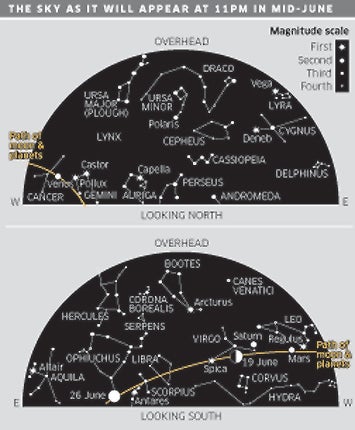The Stars: June

May's black ash from the Eyjafjallajökull eruption in Iceland might just have a silver lining... Look north at twilight this month, and you may find yourself seeing one of the sky's most ghostly phenomena: noctilucent clouds.
Their name, derived from Latin, means 'night-shining'. These are the highest clouds in the world. Our familiar mare's-tail cirrus clouds form about six miles up. Noctilucent clouds hover some 50 miles above the Earth's surface. Seen in the deep twilight, they look extremely eerie. Shining with an electric-blue glow, they seem almost unnatural. Although they appear to be powered by a neon tube, they're actually lit from below the horizon by the Sun. Like most high-level clouds, noctilucent clouds are made of tiny crystals of ice that have condensed on particles of dust. But up here – halfway to the frontier of space – where has the dust come from?
Noctilucent clouds were first observed in 1885, after the eruption of Krakatoa in 1883, and they are on the increase. Opinion is still out as to whether volcanic particles are the culprit. Climate change is also likely to be involved, but – possibly – the most telling evidence comes from the planet Mars. In 2006, researchers using Europe's Mars Express space probe reported clouds of carbon-dioxide crystals above the planet's surface. Mars has no atmospheric poll-ution, and its volcanoes are virtually extinct. So where should we put our money on the particles around which noctilucent clouds nucleate? The answer: minuscule particles of space debris. But the jury is still out!
Meanwhile, enjoy what looks to be a great cosmic light show...
What's Up
Three planets are gracing our evening skies in June. In the west after sunset, you can spot brilliant Venus even before the sky is completely dark. It's joined by the crescent Moon on 14 and 15 June. If you have a chance to look through a telescope, on 20 June you'll see Venus pass right in front of the star cluster called Praesepe (popularly called the Beehive). In the west, there's a lovely pair of bright stars – one blue-white and the other reddish. The first is Regulus, the brightest star in Leo (the lion). The other "star" is actually the planet Mars. The Red Planet passes close by Regulus on 6 June, and the Moon lies near them on 16 and 17 June.
To the left of Regulus and Mars (in the south-west), you'll find ringworld Saturn, and to the left again is Spica, the jewel in the crown of Virgo (the virgin).
And on the subject of stars, look up above Spica to find Arcturus, the fourth brightest star in the sky. It marks the base of the kite-shaped constellation of Boötes (the herdsman). Arcturus is a red giant star, which has swollen in its old age until it has reached 25 times the girth of our Sun. But even Arcturus is a celestial minnow compared to Antares, low in the south late in the evening, which is 800 times the Sun's diameter.
Diary
4: 11.13pm Moon at Last Quarter
12: 12.14pm New Moon
19: 5.29am Moon at First Quarter
21: 12.28pm Summer Solstice
26: 12.30pm Full Moon
Join our commenting forum
Join thought-provoking conversations, follow other Independent readers and see their replies
Comments